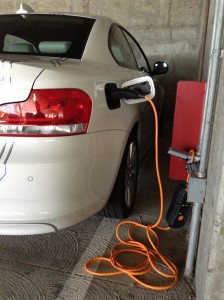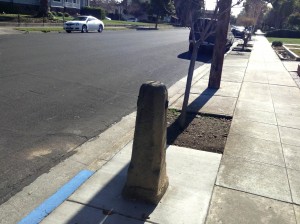California state grants aimed at multiplying electric vehicle chargers have proved helpful for many EV drivers in the Bay Area over the past couple years. But not everyone is reaping the benefits at home.
Some apartment dwellers and condo owners say they still face a circuitous process in getting approval from homeowners associations when it comes to getting a proper EV charger installed at their place of residence. Others face physical obstacles: They might not have a garage or designated parking spot. Some run lengthy cables from dryer outlets, while others have to rely on public or dealership charging stations.

These challenges facing renters — and some condo owners — come as California readies for an expected surge in electric vehicles. California Gov. Jerry Brown has estimated that 1.5 million zero-emission vehicles will be on the state roadways by 2025 – up from 20,000 now.
As of last fall, there were around 800 publicly available charging stations in the Bay Area, according to the Bay Area Air Quality Management District, and over 5,000 stations total across California. The state’s Alternative and Renewable Fuel and Vehicle Technology Program (ARFVT), established a few years ago to set aside $100 million annually for new technologies and alternative fuels, is meant to help fund the expansion of EVs and EV-charging infrastructure.
More recently, the California Energy Commission has issued at least two competitive grants, soliciting bids from local companies to install Level 2 car chargers — which are more powerful than standard home outlets — throughout municipalities and private homes. Research shows that EV owners charge at home most of the time, rather than at public charging stations.
But when it comes to getting powerful chargers installed at home, some have it easier than others.
Aaron Rogers, a Redwood City-based electrician who runs his own shop, says for several months starting last summer, he was so busy with EV charger installs in people’s homes that he had to turn down other jobs.
“I had to tell my contractors that I couldn’t do anything else; I was doing multiple installs a day,” Rogers said, due to what he believes is the trickle-down effect of a CEC grant awarded last June.
But Rogers says the overwhelming majority of his installation jobs have been for homeowners, not apartment or condo-owners. “I’ve been out to see a bunch of renters, but it usually doesn’t work out … [either] there is nowhere to pull power from, or there is a detached garage and no way to install a Level 2 charger.”
Related: Electric vehicle owners get charged up over poor manners at the ‘pump’
EV-owner George Betak struggled a couple years ago to get a charger installed at his former rental, a single-family house in Santa Clara.
The house didn’t have a driveway or garage, leaving Betak, a software engineer and tech consultant, with few options for charging his Nissan Leaf. He sometimes resorted to running an extension cord from a less-powerful outlet inside the house, he said, to his car parked on the street.
After unsuccessfully petitioning the City of Santa Clara to install a curbside charger, Betak eventually spent several thousand dollars, he says, to create a makeshift charger in an alleyway. “There was actually a city ordinance for hitching posts — so people could hitch their horses — but I couldn’t install a charger at the curb,” he said.
Betak has since moved to Milpitas, where he now rents a single-family dwelling with a garage. He uses a dryer outlet with higher voltage to charge his car.

Doris Hu, a Nissan Leaf owner who lives in South San Jose, opted for a solution similar to George Betak’s. Hu lives in a townhouse-style condo with an attached garage. But rather than go through the process of installing a full EV charger, she purchased a modified charging cable from a local engineer and hooked it up to the 220-volt dryer outlet. “Don’t need to go through HOA this way,” she explained.
Hu’s employer, the SLAC National Accelerator Laboratory, also just instituted a personal plug-in program for employees, which costs them a flat fee of $15 per month through automatic payroll deductions.
John Kalb, a consultant who works specifically on EV charger installations at multi-unit complexes, says the CEC funding for chargers at apartment complexes and condos, is “a drop in the bucket.” He points out that only about a million dollars of one of the recent CEC competitive grants — which totals $6 million — is going towards these types of residences.
Still, he argues that the problem for apartment-dwellers isn’t necessarily a technical or bureaucratic one. It might just come down to splitting the electric bill.
“How do you meter how the EV owners pay for the energy they use?” he asks. “In some apartments or condos, where you might have a deeded parking spot, you can sometimes install a separate [electrical] panel. Then you send maintenance out every three months or so and they’ll say, ‘Okay, you’ve used this many kilowatts, here’s how much you owe.’”
Kalb himself installed an EV charger for his BMW ActiveE without any resistance from his landlord at his rental property in Novato.
And there are other signs that things could get easier for electrical vehicle drivers who rent properties.
Madera Apartments in Mountain View, a 200-unit complex run by the Prometheus Real Estate Group, received a local award last year for its “EV readiness.” And Sequoia Equities in Walnut Creek just said it would install EV charging stations in 28 of its residential properties throughout the state.
Related video – “New Palo Alto homes now EV friendly,” by Vjeran Pavic:
[youtube]PyrCPr2mbNY[/youtube]
